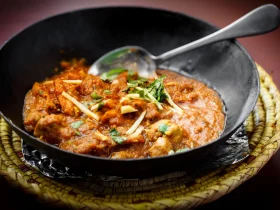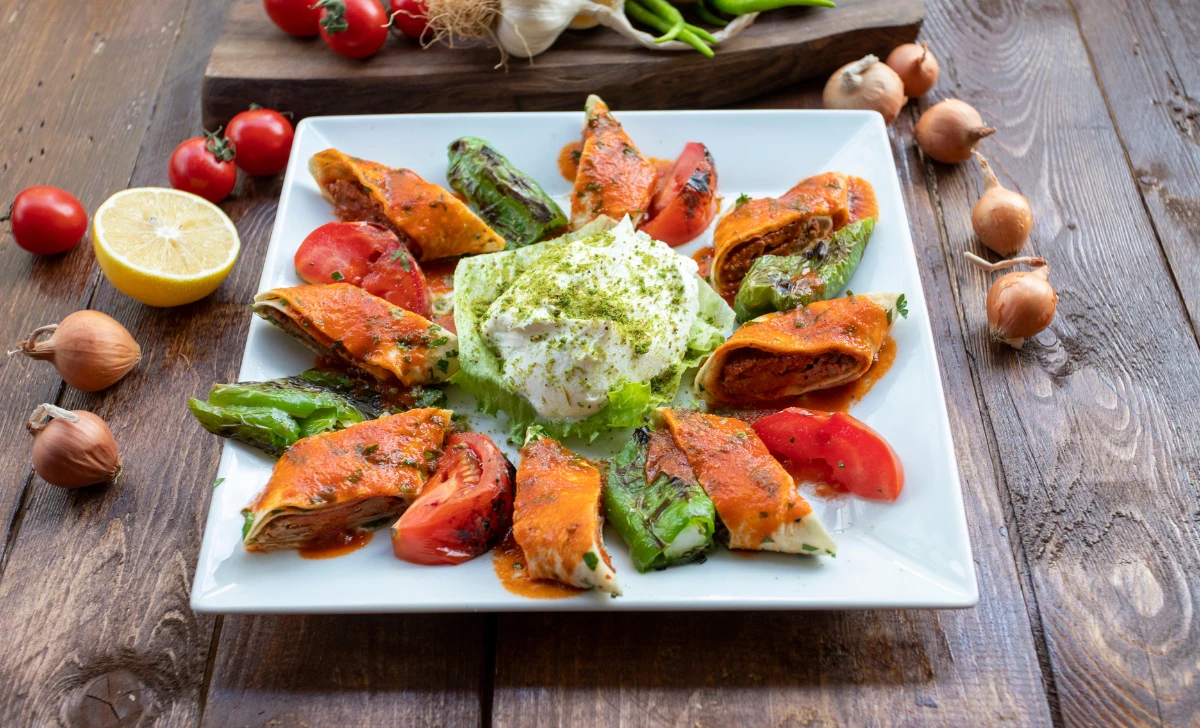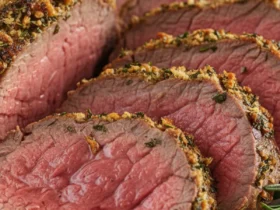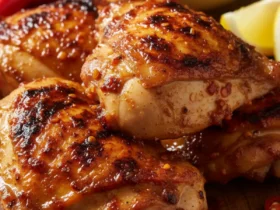There’s something magical about the sizzle of meat on a grill, the aroma that wafts through the air, and the anticipation of biting into a perfectly cooked dish. One such dish that embodies all these sensations is the Beyti Kebab. Originating from the rich culinary tapestry of Turkey, this kebab variation has gained popularity far beyond its borders. Today, we’re diving into the realm of flavors and spices to explore the art of crafting an unforgettable Beyti Kebab right in your own kitchen.
[ez-toc]
History
From the bustling streets of Turkey to the plates of food enthusiasts worldwide, the history of Beyti Kebab is a tale that intertwines culture, innovation, and a love for exceptional flavors. This beloved dish didn’t just appear overnight; it’s a culmination of centuries of culinary evolution.
Ancient Roots and Inspirations
To understand the origins of Beyti Kebab, we must journey back in time to the ancient Silk Road – the legendary trade route that connected East and West. This intricate network of routes allowed for the exchange of goods, cultures, and culinary traditions. The concept of skewered and grilled meat likely found its roots along this route, as various cultures experimented with different methods of cooking and seasoning meat.
Turkey: The Birthplace of Beyti Kebab
Fast-forward to the heart of the Ottoman Empire, where the foundations of modern Beyti Kebab were laid. The name “Beyti” itself is a homage to Beyti Güler, a celebrated Turkish chef who is said to have created this masterpiece in the mid-20th century. Inspired by traditional kebabs and the love for culinary innovation, Beyti Güler aimed to craft a kebab that would resonate with both locals and visitors.
Crafting the Classic: Beyti Kebab’s Rise to Fame
In the mid-20th century, Beyti Güler’s restaurant in Istanbul became the epicenter of this culinary sensation. The kebab’s uniqueness lay in its composition: marinated ground meat, carefully seasoned, wrapped in lavash bread, and grilled to perfection. The harmonious blend of spices, the convenience of a handheld meal, and the theatricality of grilling caught the attention of food connoisseurs and wanderers alike.
A Global Culinary Icon
As travelers ventured beyond Turkey’s borders, they carried tales of this extraordinary dish back to their home countries. Chefs and enthusiasts worldwide were captivated by the Beyti Kebab’s symphony of flavors and its elegant yet approachable presentation. As international interest grew, chefs experimented with their own variations, incorporating local ingredients and techniques.
Innovations and Variations
The journey of Beyti Kebab continued with creative adaptations. Chicken Beyti Kebab emerged as a popular alternative for those seeking a lighter option, while vegetarians were delighted with versions that featured grilled vegetables and flavorful cheeses. Each variation maintained the core essence of marinated, grilled goodness.
Modern Times: Beyti Kebab’s Legacy
In the modern culinary landscape, Beyti Kebab stands tall as an ambassador of Turkish cuisine. From casual eateries to upscale restaurants, this dish has found a home on menus across the world. Its history intertwines with Turkey’s rich cultural heritage, the spirit of innovation, and the joy of sharing good food with loved ones.
Time
| Step | Time |
|---|---|
| Marinade Preparation | 15 minutes |
| Meat Marination | 2 hours |
| Lavash Bread Preparation | 10 minutes |
| Assembling Beyti Kebab | 20 minutes |
| Preheating the Grill | 10 minutes |
| Grilling the Kebabs | 15 minutes |
| Final Garnishing | 5 minutes |
| Total | 77 minutes |
Please note that the total time provided is an estimation and may vary based on individual cooking speeds and equipment.
Ingredients
| Ingredients | Quantity |
|---|---|
| Lean ground beef or lamb | 250 grams |
| Spices (paprika, cumin, sumac) | As needed |
| Garlic | 2 cloves |
| Olive oil | 2 tablespoons |
| Salt and pepper | To taste |
| Lavash bread | 2 pieces |
| Yogurt | 1/2 cup |
| Tomato sauce | 1/4 cup |
Please adjust the quantities based on your personal preferences and any dietary restrictions.
Directions
Step 1: Crafting the Marinade
Time: 15 minutes
Start by preparing the flavor-packed marinade that will infuse your meat with a symphony of tastes.
- Gather the Spices: In a bowl, gather the paprika, cumin, sumac, and a pinch of salt and pepper. These spices will form the foundation of your marinade.
- Embrace the Aromatics: Peel and crush the garlic cloves, releasing their aromatic essence. Add them to the spice mixture.
- Elixir of Flavor: Pour the olive oil over the spice blend. This will help the spices adhere to the meat and create a flavorful coating.
- Mix with Care: Stir the ingredients together, watching as they transform into a fragrant paste. Take a moment to savor the enticing aroma.
Step 2: Marinating the Meat
Time: 2 hours
Now, it’s time to let the flavors infuse your meat, resulting in tender bites that sing with every chew.
- Prep the Meat: Take the lean ground beef or lamb and place it in a bowl. This is your canvas for culinary greatness.
- The Art of Marination: Gently massage the prepared marinade onto the meat. Ensure that every inch is coated with the rich blend of spices and aromatics.
- Patience is Key: Cover the bowl and let the meat marinate for at least 2 hours. If time permits, allow it to marinate overnight for an even more intense flavor.
Step 3: Preparing the Lavash Bread
Time: 10 minutes
Lavash bread is the cozy home for your marinated meat, providing the perfect vessel for your culinary masterpiece.
- Unveil the Lavash: Lay out the lavash bread on a clean surface. You’ll be amazed by its pliability – the perfect wrapping material.
Step 4: Assembling the Beyti Kebab
Time: 20 minutes
Now comes the artistic process of bringing together the marinated meat and the lavash bread.
- Place the Meat: Along one edge of the lavash, place a generous amount of marinated meat. Imagine this as the heart of your kebab.
- Roll with Precision: Gently roll up the lavash, securing the marinated meat inside. Think of it as creating a flavorful scroll.
- Repeat the Process: Continue this process until you’ve rolled all the lavash bread and transformed them into savory bundles of delight.
Step 5: Grilling the Kebabs
Time: 15 minutes
The grill is where the magic happens – the sizzle, the aroma, and the transformation of your culinary creation.
- Preheat the Grill: Fire up the grill and let it preheat. You want those grates to be nice and hot for that perfect sear.
- Place with Care: Gently place your rolled kebabs on the grill. Listen to the sizzle as they make contact with the hot grates.
- Watch and Turn: Keep a watchful eye as the kebabs cook. Use tongs to turn them occasionally, ensuring an even char on all sides.
Step 6: Final Garnishing and Serving
Time: 5 minutes
The moment has arrived to present your culinary masterpiece to eager taste buds.
- Plating Perfection: Carefully place the grilled kebabs on a plate, arranging them with care. The sight itself is a feast.
- Yogurt and Tomato Sauce Dance: Surround the kebabs with a dollop of yogurt and a drizzle of tomato sauce. The white and red create a visual spectacle.
- Ready to Indulge: Your Beyti Kebabs are now ready to be enjoyed. Invite your taste buds on a journey through layers of flavors and textures.
Congratulations, you’ve successfully crafted Beyti Kebabs that are as much a treat for the eyes as they are for the palate. Share this culinary adventure with a friend or loved one, and let the flavors spark conversations and laughter around the table.
Equipment Required
Nutrition Information
| Nutrition Information | Per Serving |
|---|---|
| Serving Size | 1 kebab |
| Calories | 350 kcal |
| Total Fat | 20g |
| – Saturated Fat | 6g |
| Cholesterol | 70mg |
| Sodium | 500mg |
| Total Carbohydrates | 20g |
| – Dietary Fiber | 2g |
| – Sugars | 3g |
| Protein | 25g |
Please note that these values are approximate and can vary based on factors such as ingredient brands and portion sizes. Always refer to specific product labels or consult with a nutritionist for precise dietary information.
Tips
- Quality Matters: Choose lean ground meat with just the right fat content for that juicy texture without excessive greasiness.
- Marinate with Love: Give the marinade time to work its magic. The longer the marination, the more intense the flavors.
- Temperature Precision: Preheat your grill properly – a hot grill ensures that perfect char without overcooking the meat.
- Grill Confidence: Don’t rush the grilling process. Turn the kebabs occasionally for even cooking and that beautiful grill mark.
- Lavash Love: Be gentle when rolling the lavash bread. Too much pressure can cause it to tear.
- Perfect Portions: While assembling, ensure you distribute the meat evenly for consistent flavors in every bite.
Pros & Cons
| Pros | Cons |
|---|---|
| ✅ Bursting with rich flavors | ❌ Requires marination time |
| ✅ Versatile – adaptable to dietary preferences | ❌ Grilling can be weather-dependent |
| ✅ Impressive presentation for guests | ❌ Requires outdoor grill or grill pan |
| ✅ Balanced blend of protein and carbs | ❌ May be calorie-dense for some diets |
| ✅ Customizable with various spice profiles | ❌ Lavash availability may vary |
Conclusion
As we bring our culinary journey to a close, we find ourselves at the crossroads of flavors, aromas, and memories waiting to be created. The Beyti Kebab recipe is more than just a dish; it’s an invitation to explore the world of taste, to awaken your senses, and to experience the joy of crafting a masterpiece right in your own kitchen.
From the moment you blend the spices into a fragrant marinade to the sizzle of the grill and the final flourish of garnishes, every step is an opportunity to create something extraordinary. The Beyti Kebab embodies the heart of Turkish cuisine, weaving tradition and innovation into a tapestry of flavors that will leave you and your guests thoroughly satisfied.
So why not embark on this flavorful adventure? Whether you’re a novice cook or a seasoned culinary enthusiast, the journey of crafting Beyti Kebab is an experience to savor. Gather your ingredients, unleash your creativity, and let the dance of spices and aromas unfold before you.
As you serve your Beyti Kebabs to eager diners or enjoy them in the company of loved ones, you’re not just sharing a meal – you’re sharing a piece of culture, a touch of innovation, and a world of tastes. So go ahead, fire up the grill, roll out the lavash, and let the culinary magic commence. Your taste buds and your soul will thank you for it. Bon appétit! 🍽️🔥🌯
Facts
- Fact 1: A Turkish Delight 🇹🇷
- Did you know that the Beyti Kebab was named after its creator, Beyti Güler? This Turkish chef wanted a kebab that could stand out on its own – a kebab that would forever carry his name and culinary legacy. The Beyti Kebab isn’t just a dish; it’s a tribute to creativity and innovation in the world of gastronomy.
- Fact 2: Lavash Love 🌯
- The lavash bread used to wrap Beyti Kebab isn’t just a vessel for flavor; it’s an edible canvas that’s been cherished for centuries. In Armenian culture, lavash is considered a UNESCO Intangible Cultural Heritage, symbolizing unity and community. With each roll of lavash, you’re embracing a piece of history and culture.
- Fact 3: From Silk Road to Plate 🛤️
- The concept of skewering and grilling meat that forms the foundation of Beyti Kebab can be traced back to the ancient Silk Road. This legendary trade route wasn’t just about goods; it was a conduit for flavors and culinary traditions. So, when you savor a Beyti Kebab, you’re indulging in a slice of culinary history that spans continents.
- Fact 4: Kebab Renaissance 🍢
- In the 1950s, Beyti Güler’s restaurant in Istanbul was a hub of culinary innovation. It’s said that his creation, the Beyti Kebab, marked a kebab renaissance. This dish didn’t just satisfy hunger; it ignited a passion for flavors, textures, and artistic presentations. It’s no wonder that the Beyti Kebab became a cultural icon beyond Turkey’s borders.
- Fact 5: Roll, Sizzle, Enjoy! 🔥
- As you roll up your Beyti Kebab, think of it as crafting a flavorful scroll of delight. When it hits the grill, the sizzle and aroma are more than just a cooking process; they’re a symphony of senses. Each bite takes you on a journey through layers of marinade, spices, and love – an experience that’s as much about storytelling as it is about taste.
FAQ’s
Can I use ground chicken instead of beef or lamb?
Absolutely! Ground chicken works well as a lean and flavorful alternative to beef or lamb, offering a lighter twist on the classic Beyti Kebab.
What’s the best way to reheat leftover Beyti Kebabs?
To maintain their tenderness, preheat the oven to 350°F (175°C), wrap the kebabs in foil, and bake for about 10 minutes. You can also reheat them in a covered skillet over medium heat for a few minutes.
Can I make the marinade in advance?
Yes, you can prepare the marinade ahead of time and store it in an airtight container in the refrigerator for up to 3 days. Just remember to mix it well before using.
Are there any dairy-free alternatives for the yogurt garnish?
Absolutely! You can replace the yogurt with coconut yogurt or a dairy-free sour cream alternative for a creamy finish that suits dietary restrictions.
I don’t have access to a grill – can I make these in the oven?
Certainly! Preheat your oven to 400°F (200°C), place the rolled kebabs on a baking sheet, and bake for about 15-20 minutes, turning once halfway through.
Is there a vegetarian version of Beyti Kebab?
Absolutely! Create a veggie Beyti Kebab by using marinated and grilled portobello mushrooms, zucchini, bell peppers, and your favorite vegetables as filling.
Can I freeze uncooked Beyti Kebabs for later use?
Yes, you can assemble the kebabs and freeze them on a baking sheet. Once frozen, transfer them to an airtight container or freezer bag. Thaw before grilling.
What side dishes pair well with Beyti Kebab?
Fluffy rice, tabbouleh salad, hummus, and grilled vegetables are excellent companions that enhance the Beyti Kebab experience.
Is sumac a crucial ingredient, or can I skip it?
While sumac adds a unique tangy flavor, you can skip it if needed. Consider using a pinch of lemon zest as a substitute for a hint of acidity.
Can I use store-bought lavash instead of making it?
Absolutely! Store-bought lavash can save time and effort. Just ensure it’s pliable enough to roll without tearing, and you’re good to go!












Leave a Review